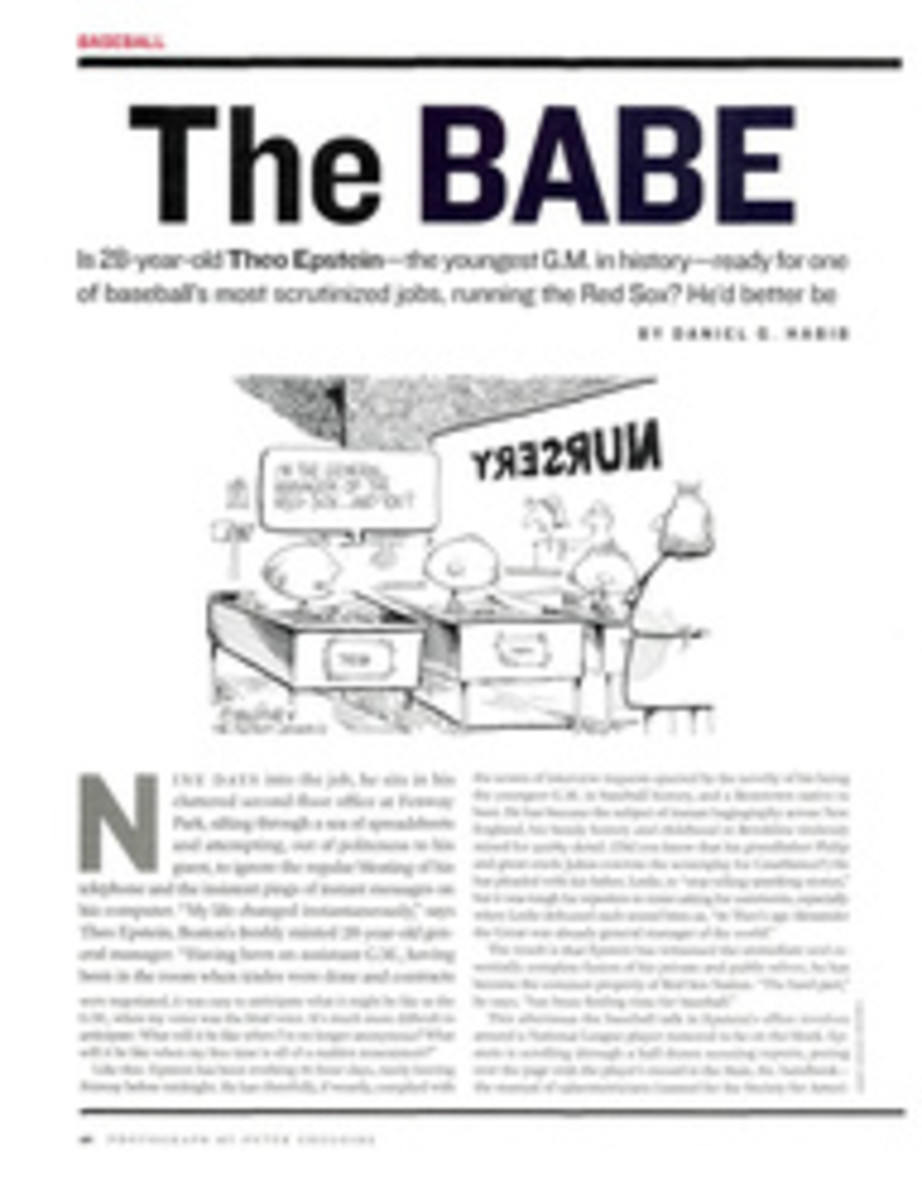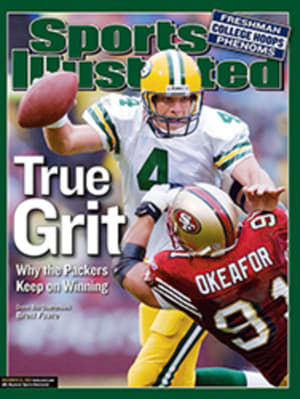
Magic Touch Not even Penguins teammate Mario Lemieux can match Alexei Kovalev for on-ice wizardry
This question was asked of Pittsburgh Penguins players: If Mario
Lemieux and Alexei Kovalev were airlifted to a frozen pond in
northern Ontario, given sticks and a puck and asked to do the
most spectacular hockey tricks imaginable, who would win--Mario
the Magician or the Sorcerer's Apprentice?
There were wows and hedges and political calculations ("He signs
my checks," fourth-line wing Steve McKenna said of Lemieux, who
also owns the team), and in the end the vote was too close to
call. Lemieux has spent his career undressing the NHL's best
defensemen with his savvy and slickness. But can he drop to his
knees just inside the blue line and saucer the puck 40 feet in
the air so it lands on top of the net? Can he, at full speed,
put a skate atop the puck, pirouette almost 360 degrees and kick
the puck ahead to himself? Kovalev, a right wing, does both of
those things.
The swing vote came from an unexpected precinct. "I'd say Kovy,"
Lemieux admitted. "He's the best stickhandler I've ever seen.
Quickness. Hands. A much better stickhandler than me. He's got
the talent to be the best player in the world."
Kovalev's game is all curlicues and grace notes: rococo art in an
age of dump-in simplicity. He doesn't play hockey, he ornaments
it. There are eight million stories of his virtuosity in the
naked dressing room, but a favorite is the hat trick he completed
against the New York Islanders last season by bursting down the
wing, shooting off his back foot as he crossed the goal line and
beating Garth Snow high to the short side from a wicked angle--a
shot that drew a stare from Snow and a laugh from Kovalev. He
raised the bar, then roofed the puck under it.
"How do painters come up with ideas?" Kovalev asked rhetorically
as he picked at a chicken Caesar salad one recent afternoon.
"Maybe something comes into their heads, and they think about it,
and that's what they end up painting. Same thing with me.
Something comes into my head, and I'll try it. It looks funny and
unreal at first, but then you keep doing it, and it becomes
easier."
Kovalev is 6'1" and 221 pounds of hockey inventiveness, the
perfect marriage of man, stick and puck. Through Sunday he was
tied for second in the NHL, with 39 points, and first in
aesthetics. "He's one of those guys you watch even when he's on
the ice by himself," Penguins defenseman Jamie Pushor says. "You
can watch a guy shoot hoops alone, but you generally wouldn't
watch a hockey player. Except him."
The background: an indifferent crowd on a November night in
Sunrise, Fla. The foreground: the Pittsburgh line of Kovalev,
Lemieux and wing Aleksey Morozov. The scene: The three Penguins
come out whipping the puck around against the Florida Panthers
with such brio that those in charge of the in-house music during
stoppages should dispense with the rock and roll and play Sweet
Georgia Brown. The only trick Kovalev doesn't pull in the first
period is the confetti-in-the-water-bucket move. Three times in
one play he beats defenseman Ivan Majesky, who chases him around
the left face-off circle like a golden retriever.
But in the second period the masterstrokes turn into
fingerpainting, a mess of blind passes. This is art for art's
sake, not hockey's, and it is the sort of display that has marred
Kovalev's audacious work throughout his pro career, which began
with the New York Rangers in 1992--93. Lately he has become a
superior finisher--he scored 44 goals in 2000--01, 18 more than
his previous best--and over the past two-plus seasons he has
ranked sixth in shots, having overcome an innate Russian
reticence about firing the puck. Yet in weak moments he chooses
style over substance.
"His game has changed," Penguins defenseman Ian Moran says. "But
he still enjoys beating guys one-on-one too much." For instance,
against Florida on this night Kovalev runs out of room along the
boards and drops a soft pass to Lemieux that results in a
turnover and a four-on-two rush by the Panthers. Kovalev makes
almost no effort to get back into the play. He is out of gas at
the end of a shift that lasts too long, which recalls an incident
eight years ago that became the signature piece in his portfolio.
Kovalev scored the goal that preceded Mark Messier's famous hat
trick in Game 6 of the 1994 semifinals between the Rangers and
the New Jersey Devils; and the next postseason he lay on the ice
long enough after getting slashed for the referee to stop play
and disallow a Quebec Nordiques' goal; but the most memorable
story about him involves a game against the Boston Bruins in
1994. Kovalev had been overstaying his standard 45-second shift
so routinely that in the third period, when he finally skated to
the bench for a change, the exasperated Rangers coach, Mike
Keenan, waved at him to stay on the ice. This went on and on
until the game was over. Depending on whom you believe, Kovalev
played a record 11-or nine-or four-minute shift. Keenan has
always maintained that until his teammates clued him in following
the match, Kovalev thought he was being rewarded rather than
punished. Kovalev, however, insists he had it figured out within
three minutes.
In Pittsburgh things do not always have to be accomplished in a
New York minute. The Eurocentric Penguins have a loose group
because management usually allows players to find their own
comfort level by letting them be creative on the ice. A liberated
Kovalev, who was shipped to Pittsburgh in November 1998 for
center Petr Nedved, ultimately became a point-a-game player.
Through Sunday he had 322 points in 320 career matches with the
Penguins.
While those numbers qualify Kovalev for stardom in the Dead Puck
Era, Lemieux matter-of-factly notes that his teammate's stats
"aren't great" for a player so gifted. Kovalev's effort is beyond
reproach; he consistently is the last player to leave the ice
after practice, a lifelong habit. As teenagers with Dynamo
Moscow, Kovalev and Islanders center Alexei Yashin would slip out
of the dormitory, grab keys to the rink and play shinny late into
the night. Kovalev often would tug on goaltender's gear and play
in the cage to develop a better feel for what a netminder could
and couldn't stop.
"He's so analytical," Penguins center Kent Manderville says.
"He's out there after practice working on one-timers from the
point"--Kovalev is the rare NHL forward who quarterbacks the
power play--"and talking about keeping square to the pass and not
opening up the hips so you can come through quicker. Almost like
a golf pro." Kovalev, in fact, won the club championship last
summer at Willow Ridge Country Club in Harrison, N.Y., beating
men who, he says, "got nervous because they aren't pro athletes.
I'm used to pressure."
Kovalev's interest in golf was piqued at his first NHL training
camp, in 1992, when he saw New York forward Joe Kocur hit a drive
from his knees during a Rangers outing. The only language Kovalev
shared with Kocur at the time was athleticism, but one year later
Kovalev showed off the same trick shot to delighted teammates.
"My life can't just get stuck on hockey," Kovalev says. "I've
always been interested in everything, and I want to learn."
When his fingers proved too thick to pluck guitar strings,
Kovalev took up the saxophone, which he learned from a Russian
jazzman named Igor Butman in New York City. Kovalev also became a
pilot after a friend took him on a low-altitude flight over
Manhattan six years ago. Now Kovalev, who logs 90 to 100 hours of
flying time per year, owns a six-seat Cessna 414. That proved
handy in early October, when he dropped off prospect Konstantin
Koltsov with the Penguins' farm team in Wilkes-Barre, Pa., while
en route to New York to help move his wife, Eugeni, and infant
son, Nikita, to Pittsburgh for the season.
The next big move for the 29year-old Kovalev, who is earning $4.6
million this season, could be out of Pittsburgh. He has
arbitration rights next season and the presumed bonanza of
unrestricted free agency in 2004. Fleeing the artists' colony in
Pittsburgh might be lousy for his career--he won't ride shotgun
for Lemieux or have the same degree of freedom in another
system--but he would undoubtedly become the best-paid freelancer
in history.
"As players we learn a lot about the game and ourselves as we
progress through our careers," says Manderville. "For Alexei it's
a much more pronounced education because of his skill. In the
final part of last year, with Mario out [with a hip injury], the
team relied on Alexei heavily to produce. He did. And he
definitely has another level beyond that. Certainly there's a
fire in his eyes."
That is either fire or the glimmer of an idea for his next
suitable-for-framing star turn. He was watching a tape of his old
goals recently and saw a wraparound move in which he came down
the left side handling the puck on his forehand and circled the
net. He figures that the next time, instead of trying to stuff
the puck inside the post, he'll keep going, keep drifting, keep
patient and, poof, top-shelf. Coming soon to an 18,000-seat
frozen pond near you.
COLOR PHOTO: PHOTOGRAPH BY BOB ROSATO PORTRAIT OF BRILLIANCE Kovalev is so adept with the puck that he's the rare NHL forward who runs the power play.
COLOR PHOTO: LOU CAPOZZOLA POTENT PENGUIN Kovalev, the NHL's No. 2 scorer, became a point-a-game man after Pittsburgh acquired him in '98.
"He's the best stickhandler I've ever seen," says Lemieux, "He's
got the TALENT TO BE THE BEST PLAYER in the world."

